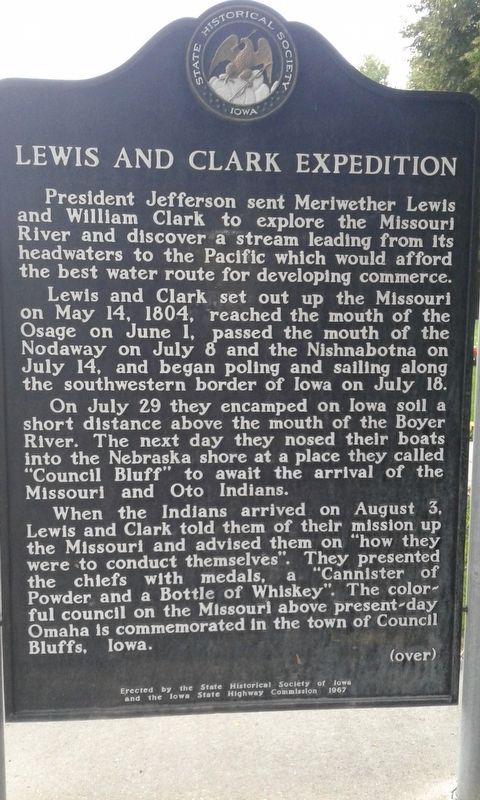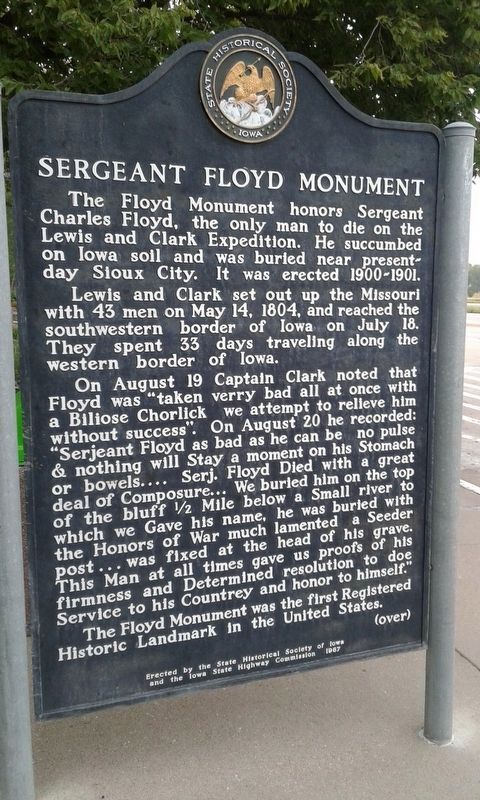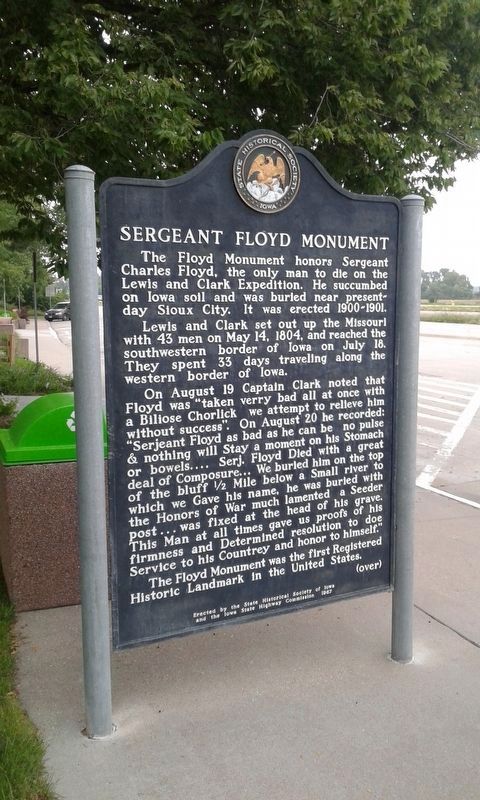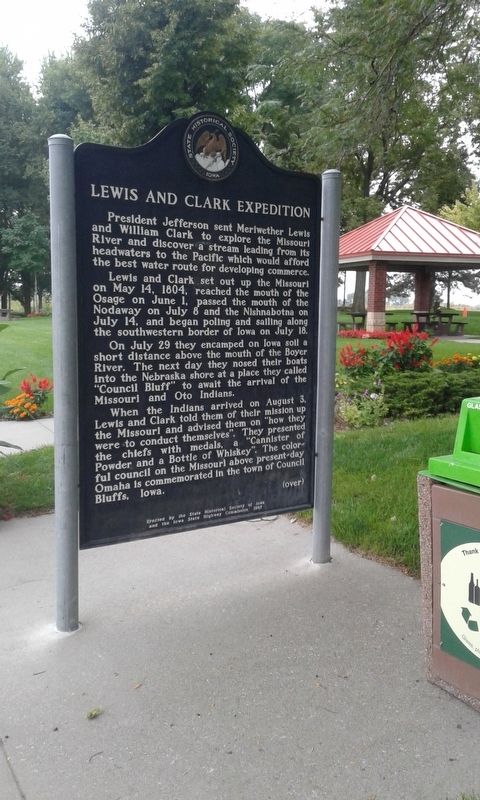Sergeant Bluff in Woodbury County, Iowa — The American Midwest (Upper Plains)
Lewis and Clark Expedition / Sergeant Floyd Monument
Lewis and Clark set out up the Missouri on May 14, 1804, reached the mouth of the Osage on June 1, passed the mouth of the Nodaway on July 8 and the Nishnabotna on July 14, and began poling and sailing along the southwestern border of lows on July 18.
On July 29 they encamped on Iowa soil a short distance above the mouth of the Boyer River. The next day they nosed their boats into the Nebraska shore at a place they called "Council Bluff” to await the arrival of the Missouri and Oto Indians.
When the Indians arrived on August 3, Lewis and Clark told them of their mission up the Missouri and advised them on "how they were to conduct themselves". They presented the chiefs with medals, a "Canister of Powder and a Bottle of Whiskey". The colorful council on the Missouri above present-day Omaha is commemorated in the town of Council Bluffs, Iowa.
Lewis and Clark set out up the Missouri with 43 men on May 14, 1804, and reached the southern border of Iowa on July 18. They spent 33 days traveling along the western border of Iowa.
On August 19 Captain Clark noted that Floyd was "taken verry bad all at once with Biliose Chorlick we attempt to relieve him without success." On August 20 he recorded: "Sergeant Floyd as bad as he can be no pulse & nothing will Stay a moment on his Stomach or bowels.... Serj. Floyd Died with a great deal of Composure... We buried him on top of the bluff ˝ mile below a Small river to which we Gave his name, he was buried with the Honors of War much lamented a Seeder post... was fixed at the head of his grave. This Man at all times gave us proofs of his firmness and Determined resolution to doe Service to his Countrey and honor to himself."
The Floyd Monument was the first Registered Historic Landmark in the United States.
Erected 1967 by State Historical Society of Iowa and the Iowa State Highway Commission. (Marker Number 8.)
Topics and series. This historical marker and monument is listed in these topic lists: Exploration • Waterways & Vessels. In addition, it is included in the Iowa - State Historical Society of Iowa series list. A significant historical date for this entry is May 14, 1804.
Location. 42° 22.508′ N, 96° 21.288′ W. Marker is in Sergeant Bluff, Iowa, in Woodbury County. Marker is on Interstate 29 at milepost 140,, 1.9 miles south of 1st Street, on the right when traveling south. Located at Southbound I-29 Sergeant Bluff Rest Area #15. Touch for map. Marker is in this post office area: Sergeant Bluff IA 51054, United States of America. Touch for directions.
Other nearby markers. At least 8 other markers are within 6 miles of this marker, measured as the crow flies. "Corps Of Discovery" (a few steps from this marker); August 3, 1804 (within shouting distance of this marker); August 8, 1804 (within shouting distance of this marker); August 16, 1804 (within shouting distance of this marker); Territorial Church (approx. 4.1 miles away in Nebraska); Tonwantonga (approx. 5.7 miles away in Nebraska); Herbert Quick Ravine (approx. 5.8 miles away); First Bride's Grave (approx. 5.8 miles away).
More about this monument. The misspellings in the Sergeant Floyd marker are as written by Captain Clark.
Also see . . .
1. Wikipedia article on the Lewis And Clark Expedition. (Submitted on December 4, 2020.)
2. Wikipedia article on the Sergeant Floyd Monument. (Submitted on December 4, 2020.)
Credits. This page was last revised on May 29, 2023. It was originally submitted on December 4, 2020, by Craig Doda of Napoleon, Ohio. This page has been viewed 256 times since then and 38 times this year. Last updated on May 28, 2023, by Jeff Leichsenring of Garland, Texas. Photos: 1. submitted on December 4, 2020, by Craig Doda of Napoleon, Ohio. 2, 3. submitted on December 5, 2020, by Craig Doda of Napoleon, Ohio. 4. submitted on December 4, 2020, by Craig Doda of Napoleon, Ohio. • J. Makali Bruton was the editor who published this page.
Editor’s want-list for this marker. A wide shot of the marker and its surroundings. • Can you help?



